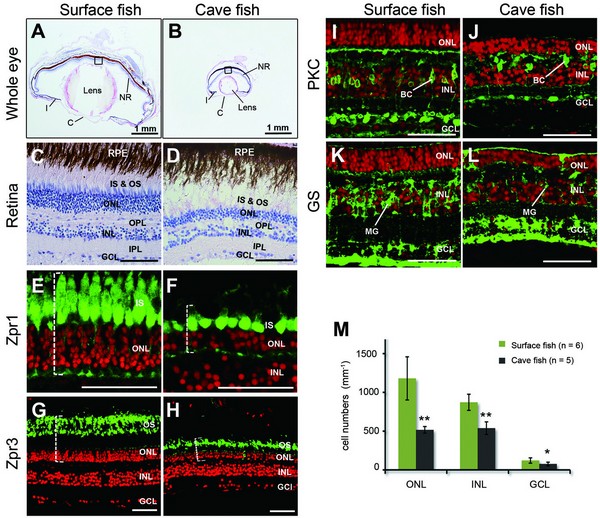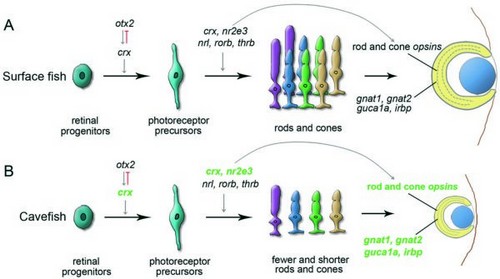Cave animals evolve distinct troglomorphic characters in perpetual darkness, most commonly, the reduction of eyesight, pigmentation, pineal organ, and scales, countered by augmented chemoreceptors, mechanoreceptors, and lipid storage. The most extensive investigation of the evolution of troglodyte traits in cavefish comes from investigations of the Mexican tetra Astyanax mexicanus. In cave Astyanax, lens apoptosis associated with over-expression of sonic hedgehog (shh) induces eye degeneration. Although troglodyte features evolved independently many times in cavefish, we do not yet know whether independent evolution of these characters involves common genetic mechanisms. The freshwater teleost genus Sinocyclocheilus (Cypriniformes: Cyprinidae) is endemic to the karst region of the east Yungui Plateau and northwest Guangxi in southwestern China. The genus includes many surface-dwelling species and at least 10 cave dwelling species with different degrees of eye degeneration. The research on a variety of cave-animal models is necessary to understand whether independent evolutionary lineages utilize related molecular genetic mechanisms, or if evolution can achieve similar results by different mechanisms.
We compared the mature retinal histology of surface and cave species in Sinocyclocheilus and found that adult cavefish showed a reduction in the number and length of photoreceptor cells. To identify genes and genetic pathways that evolved in constant darkness, we used RNA-seq to compare eyes of surface and cave species. De novo transcriptome assemblies were developed for both species, and contigs were annotated with gene ontology. Results from cave-dwelling Sinocyclocheilus revealed reduced transcription of phototransduction and other genes important for retinal function. In contrast to the blind Mexican tetra cavefish Astyanax mexicanus, our results on morphologies and gene expression suggest that evolved retinal reduction in cave-dwelling Sinocyclocheilus occurs in a lens-independent fashion by the reduced proliferation and downregulation of transcriptional factors shown to have direct roles in retinal development and maintenance, including cone-rod homeobox (crx) and Wnt pathway members. These results show that the independent evolution of retinal degeneration in cavefish can occur by different developmental genetic mechanisms.
This work was published in Molecular Biology and Evolution on Jun, 2013, doi: 10.1093/molbev/mst079. This work was supported by National Program on Key Basic Research Project (2011CB943800) and National Institute of Health grants R01 RR020833-06 (alias R01 OD011116) to J.H.P. and R24 RR032670 to J.H.P. and W. Cresko.
Eye degeneration in cavefish Sinocyclocheilus anophthalmus.
Proposed model for the evolution of eye degeneration in the cavefish Sinocyclocheilus anophthalmus


